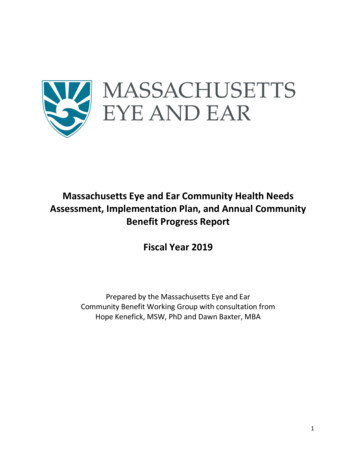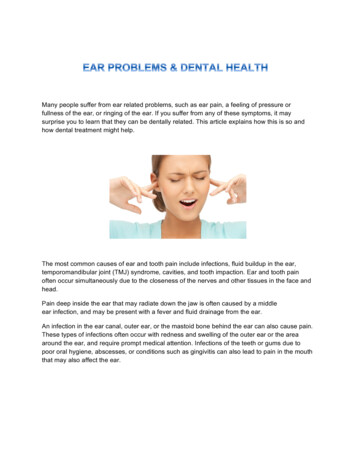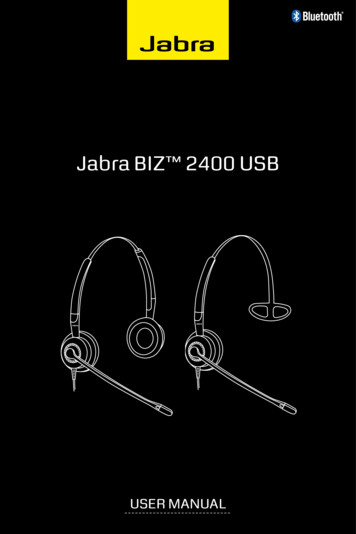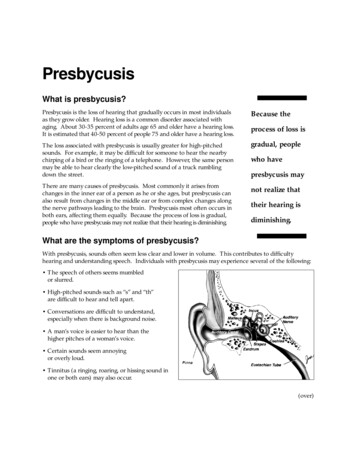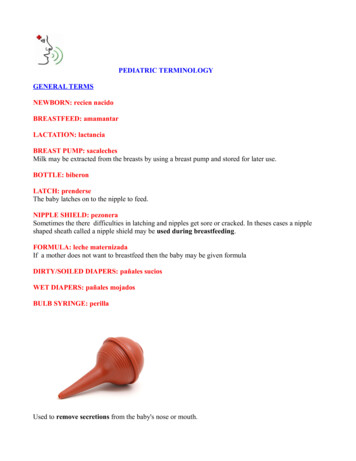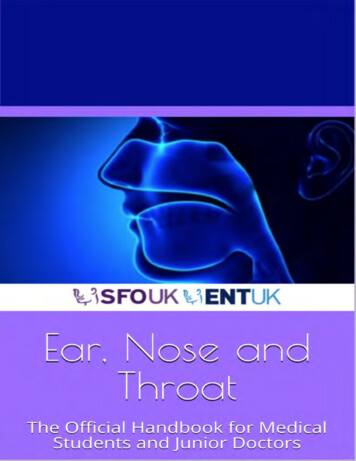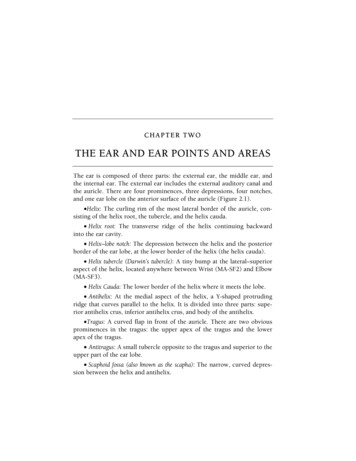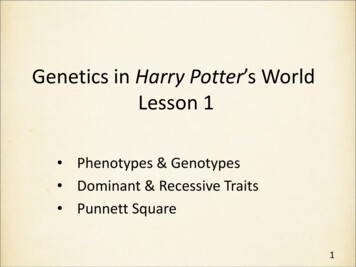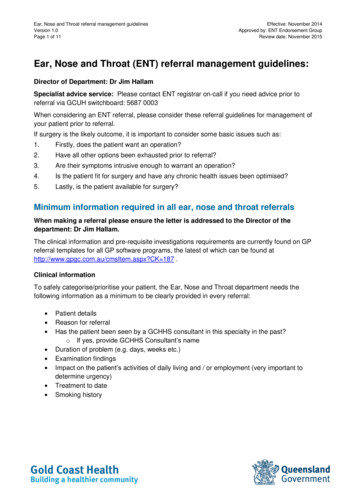
Transcription
Ear, Nose and Throat referral management guidelinesVersion 1.0Page 1 of 11Effective: November 2014Approved by: ENT Endorsement GroupReview date: November 2015Ear, Nose and Throat (ENT) referral management guidelines:Director of Department: Dr Jim HallamSpecialist advice service: Please contact ENT registrar on-call if you need advice prior toreferral via GCUH switchboard: 5687 0003When considering an ENT referral, please consider these referral guidelines for management ofyour patient prior to referral.If surgery is the likely outcome, it is important to consider some basic issues such as:1.Firstly, does the patient want an operation?2.Have all other options been exhausted prior to referral?3.Are their symptoms intrusive enough to warrant an operation?4.Is the patient fit for surgery and have any chronic health issues been optimised?5.Lastly, is the patient available for surgery?Minimum information required in all ear, nose and throat referralsWhen making a referral please ensure the letter is addressed to the Director of thedepartment: Dr Jim Hallam.The clinical information and pre-requisite investigations requirements are currently found on GPreferral templates for all GP software programs, the latest of which can be found athttp://www.gpgc.com.au/cmsItem.aspx?CK 187 .Clinical informationTo safely categorise/prioritise your patient, the Ear, Nose and Throat department needs thefollowing information as a minimum to be clearly provided in every referral:Patient detailsReason for referralHas the patient been seen by a GCHHS consultant in this specialty in the past?o If yes, provide GCHHS Consultant’s nameDuration of problem (e.g. days, weeks etc.)Examination findingsImpact on the patient’s activities of daily living and / or employment (very important todetermine urgency)Treatment to dateSmoking history
Ear, Nose and Throat referral management guidelinesVersion 1.0Page 2 of 11Effective: November 2014Approved by: ENT Endorsement GroupReview date: November 2015Pre-requisite investigations requiredPlease only send investigations relevant to the treating clinician (as requested).A list of audiology services available (for audiograms) on the Gold Coast can be found at theAudiology Australia website.If the clinical information or pre-requisite investigations are not clearly provided,your referral may be returned to you asking for more information.Services provided (click to navigate to area)EarOtheroooooooRecurrent Otitis MediaMiddle Ear Effusion (Glue Ear)Ear Drum PerforationChronic Ear DiseaseTinnitusVertigoSudden Hearing LossooooENT Head & Neck OncologyoNoseoooooAcute / chronic / recurrentRhino-sinusitisAllergic RhinitisNasal congestion / obstructionRecurrent EpistaxisNasal reconstruction /RhinoplastyThroatoTonsillitisPaediatric OSAAdult OSADysphagiaDysphoniaPaediatric speech disturbanceSuspicious head & neckmalignanciesHead & Neck – SkinMalignanciesURGENT REFERRALSooooooooooFacial palsyThyroid Masses – Benign &MalignantSalivary StonesSalivary MassSudden Hearing LossAdult OSASuspicious head & neckmalignanciesHead & Neck – SkinMalignancies
Ear, Nose and Throat referral management guidelinesVersion 1.0Page 3 of 11Effective: November 2014Approved by: ENT Endorsement GroupReview date: November 2015Condition specific guidelinesEarDiagnosisRecurrent OtitisMediaRecurrent earinfectionsassociated withURTIs, otalgia,recurrent eardischargeEvaluationMUST have recentaudiogram (withinpreceding 6 months)ManagementTreat acute episodes:Amoxicillin (45mg/kg) BDfor 10 days ORAugmentin duo (45mg/kg)BD for 10 daysCiprofloxacin HC TDS for3-7 days if otorrheaManage environmentalfactors:Consider adjustingdaycare attendance (or tosmaller daycare facility)Discuss with parents riskof passive smoke andAOM (RR-1.66)Encourage weaning ofpacifier after 11 months(RR-1.24)Middle EarEffusion (GlueEar)Hearing loss,balance andcoordinationproblems,speech andlanguage delayMUST have recentaudiogram (withinpreceding 6 months)May instigate intranasalsteroids IF child hasassociated nasal congestion /rhinorrhea and if older than 2,and NO contraindications(e.g. mometasone 5mcgnocte) – no conclusiveevidence of benefitManage environmentalfactors (till definitive surgery)When to referRecurrent earinfections with resultingsocial/developmentalconcernsRecurrent earinfections withassociated otorrhoeaChild with craniofacialabnormalitySpeech developmentdelayPersistent audiologicalevidence of effusionlonger than 4 monthsAudiological evidenceof bilateral effusionwith history suggestiveof developmental delayin infantAudiological evidenceof effusion with historyEncourage parents andsuggestive ofteachers to speak clearly and social/classroomdirectly to childimpairment in schoolaged childrenEncourage parents to notifyteacher so as to best positionchild in class
Ear, Nose and Throat referral management guidelinesVersion 1.0Page 4 of 11DiagnosisEvaluationEffective: November 2014Approved by: ENT Endorsement GroupReview date: November 2015ManagementEar DrumPerforationTopical ear medication, Review after 3 monthsKeep ear dryChronic orrecurrent eardischarge,hearing lossAudiogramChronic EarDiseaseAudiogramChronic eardischarge whichis discharge forlonger than 3monthsTinnitusCiprofloxacin HC tds for 1weekKeep ear dryNo irrigation of earWhen to referRecurrent episodes ofdischarging ear,persistent dischargedespite treatment,deteriorating hearing,when vertigo existswith acute perforationDischarging ear forlonger than 3 months,failure to settle withtopical medication,otalgia, headaches,vertigoComplications i.e.meningitis, facial palsy,vertigoAudiogramRefer to Australian HearingServices for options e.g.:masking hearing aidUnilateralsensorineuraldeafness, anceElectrocardiogramcardiac factorsDix Hallpike manoeveur todiagnose BPPV and Epleysmanoeveur to manage.Intractable rotatoryvertigo resistant toconservativemeasures. Unilateralhearing loss andtinnitus.ChronicunilateraltinnitusCT BrainBloods incl. fastingglucoseSudden Hearing AudiogramLossDefined assensorineuralhearing loss ofat least 30dBover threefrequencies ofless than threedays durationConsider non vestibularcauses of dizziness e.g. presyncope, syncope,cardiovascular, psychiatric,medication or central causesIf sensorineural hearing loss All patients should beconfirmed on audiogram, and referred for properotological examinationworkupconfirms normal tympanicmembranes, Oral steroids ifnot contraindicated at a doseof 1mg/kg tapering over 10days.
Ear, Nose and Throat referral management guidelinesVersion 1.0Page 5 of 11Effective: November 2014Approved by: ENT Endorsement GroupReview date: November 2015NoseDiagnosisEvaluationAcute / chronic / Establish diseaserecurrent Rhino- entity (chronic –sinusitispersistent Symptoms 8 weeks, recurrent Nasal 3 episodes / yr)ObstructionNasal discharge Initiate medicalmanagementFacial pain /Needs recentFrontalparanasal sinus CT &HeadachesCT Brain confirmingDisturbance ofsinomucosal diseasesmell and taste (ideally post full courseof medical Mx)Manage co-existingallergiesManagementWhen to referTreat any acute bacterialinfection appropriately (10day course of Augmentin duoforte)Failed maximalmedical managementwith CT evidence ofsinus diseaseMedical Management – 3months ofComplicated sinusdisease (extrasinusextension, suggestionof fungal disease)Oral Roxithromycin 300mgdailyI/N saline rinse/irrigation (notspray) BD-TDSI/N mometasone (BD for 2weeks, then nocte after)5 days only of BDoxymetazoline at start ofcourseIf symptoms persistent atclose of treatment – CTsinuses (no point in scanningbefore medical management)If rhinorrhea predominantsymptom – add eitherAtrovent spray OR 2ndgeneration antihistamineManage environmentalfactors:Manage any co-existingallergiesDiscuss contribution ofsmokingDiscuss role ofenvironmental andhousehold pollutants(wood/coal smoke,incense, perfumes,chlorine)(see diagram below)
Ear, Nose and Throat referral management guidelinesVersion 1.0Page 6 of 11DiagnosisAllergic RhinitisNasalcongestion /obstructionBlocked NoseEvaluationRAST /IgE (selecthouse mix, pollenmix, animal mix,grass mix)If solely forobstruction – noworkup necessaryEffective: November 2014Approved by: ENT Endorsement GroupReview date: November 2015ManagementManagement sinonasalinflammation (medicalmanagement)2 month course of:5 days only of BDoxymetazoline at start ofcourseI/N mometasone (BD for 2weeks, then noctetherafter)BD-TDS salinerinse/irrigationManagement ofenvironmental factorsManage any co-existingallergiesWhen to referOnce failed adequatemedical managementPost traumatic wherethe patient has decidedthey want surgicalmanagement
Ear, Nose and Throat referral management guidelinesVersion 1.0Page 7 of 11DiagnosisEvaluationEffective: November 2014Approved by: ENT Endorsement GroupReview date: November 2015ManagementWhen to referDiscuss contribution ofsmokingDiscuss role ofenvironmental andhousehold pollutants(wood/coal smoke,incense, perfumes,chlorine)RecurrentEpistaxisRule out anycoagulation disorderAvoidance of precipitatingfactors such as nose pickingRecurrent nosebleedsRule out any nasalmasses or foreignbodyTopical ointment BD for 1weekNasalreconstruction /RhinoplastyIf sole obstructionthan no workupnecessaryManagement sinonasalinflammation (medicalmanagement)Nasalobstruction withexternal nasaldeformityCT Scan2 month course of:Once failed adequatemedical managementIf bleeding heavy referral toemergency department maybe necessary5 days only of BDoxymetazoline at start ofcourseI/N mometasone (BD for 2weeks, then noctetherafter)BD-TDS salinerinse/irrigationManagement ofenvironmental factorsManage any co-existingallergiesDiscuss contribution ofsmokingDiscuss role ofenvironmental andhousehold pollutants(wood/coal smoke,incense, perfumes,chlorineOnce failed adequatemedical managementPost traumatic wherethe patient has decidedthey want surgicalmanagement
Ear, Nose and Throat referral management guidelinesVersion 1.0Page 8 of 11Effective: November 2014Approved by: ENT Endorsement GroupReview date: November entManage acute episodesRecurrentTonsillitisWhen to referWhen the frequency ofattacks are causingsignificant educational/ social constraints thatall involved want toconsider surgeryClassic Paradisecriteria (7 in past year,5/yr over 2 years, or3/yr for over 3 years) )or missed 4 weeksschool / 3 weeks work2 prior episodes ofquinsy in someonewith no history ofrecurrent tonsillitis OR1 quinsy if there ishistoryPaediatric OSAManage allergy/nasalCo-existing craniofacialcongestion (nasal salineabnormalityspray /- intranasal steroids ifSnoring with obviousnot contraindicated)obstructive featuresManage environmental(apnoea/choking)factorsSnoringDiscuss with parents risks ofpassive smoke exposureAdult OSASnoringReferral to sleepphysician forevaluation, PSG, andconsideration of CPAPBariatric referral ifBMI 30Medically manage nasalobstructionLong-term intranasalsteroids (mometasone) ifno contraindicationsManage allergiesWeight LossManage environmentalfactors:Discuss and managebasic sleep hygieneONLY After respiratoryassessment withPolysomnography(PSG) andconsideration/trial ofCPAPIf BMI greater than 30– NEEDS to haveadequately attemptedweight loss programme(including review withbariatric surgeon) and
Ear, Nose and Throat referral management guidelinesVersion 1.0Page 9 of 11DiagnosisEvaluationEffective: November 2014Approved by: ENT Endorsement GroupReview date: November 2015ManagementWhen to referissuesbeen intolerant ofDiscuss effects of smoking maximal medicalmanagementand alcohol intakeCounsel regarding safety forwork and driving whileuntreatedIf respiratoryassessment findspredominant problemis nasal obstruction(irrespective of BMI)DifficultyswallowingBarium swallow ifsymptoms indicatesignificant stenoticlesionReferral may be required ifthere is suspicion of a sinisterpathology in a patient withhistory of smoking andalcohol intake.Referral may berequired if there issuspicion of a sinisterpathology with historyof weight lossDysphoniaNil requiredIf acute then treat with acourse of antibiotic ifsuspicion of infectionPersistent hoarsenessin a smoker and historyof excessive alcoholintake which failsimprove withconservative measuresafter 3 weeks.DysphagiaHoarse voiceRemoval of irritants such assmoking, allergies, etc.Removal of voice abuse andadvice regarding peech therapistassessmentPoor speechconsistent withage of the childIf audiogram normal, Speechtherapy inputIf audiogram abnormalmanage otitis media asaboveIf above measures failto show anyimprovement in speechand suspicion ofsensorineural hearingloss on audiogramOtherDiagnosisEvaluationFacial palsyNil requiredLower motorneuron facialpalsyRule out Ramsay HuntsyndromeManagementWhen to referIf Bells Palsy suspected treat appropriately with oralsteroids if not contraindicated(1mg/kg of weight) Notecaution in elderly patient.Patient needs to becounselled regarding sideeffects. Oral anti-virals mayAssociated hearingloss or other suspectedcranial nerveinvolvement. Failure ofimprovement in facialweakness after 3weeks despite abovemeasures
Ear, Nose and Throat referral management guidelinesVersion 1.0Page 10 of 11DiagnosisEffective: November 2014Approved by: ENT Endorsement GroupReview date: November 2015EvaluationManagementWhen to referalso be used.Thyroid Masses– Benign &MalignantUSS /- FNA based on If benign, GP-arranged F/Uwhether any sinisterUSS (no need for referral)ultrasound featuresIf benign but concerned re:TSH and free T4large mass, compressivesymptoms, cosmesis - referCT with IV contrast ifwith USS and blood tests aslateral neck diseaseaboveRefer if:Salivary StonesUltrasoundFailure of medicalmanagementHydration, Heat Packs,Massage and SialogoguesMalignancysuspicious FNAcompressivesymptomscosmesisAntibiotics if infectedSalivary MassUSS /or CT scanFNAIf FNA result / size ofmass needs surgicalmanagementENT Head & Neck OncologyDiagnosisEvaluationSuspicious head For neck lumps 6weeks in ADULTS& neckmalignancies- Initially CT or USS ofDiagnosis,neck /- FNAinvestigationRoutine bloods (FBCandand film, ESR, U&E’s)management ofFor neck lumps patients withmalignancies of 6weeks in CHILDRENthe head andRoutine bloods ifneck, oralsuspect lymphomacavity, throat,(FBC and film,nose andESR, U&E’s) but ifsinuses, salivarypaediatricglands andcongenital lesionthyroid.no bloods requiredCertain benignFor Head & Neck Skinconditions areCancersalso catered for,Biopsy (punch) fore.g. thyroid andhistologysalivary glands.ManagementWhen to referFor all suspectedmalignancies markyour referrals asURGENTAny airwaycompromise pleasecontact the ENTregistrar on-call viaGCUH Switchboard:5687 0003
Ear, Nose and Throat referral management guidelinesVersion 1.0Page 11 of 11DiagnosisEvaluationEffective: November 2014Approved by: ENT Endorsement GroupReview date: November 2015ManagementWhen to referPaediatric headand neckmalignancyreferrals arealso accepted.Head & Neck –SkinMalignanciesBiopsyCT or MRI if deep extension / Refer if concern re:bone or nodal involvementpositive marginComplex lesionrequiringreconstructionCosmetically sensitiveareaRecurrent lesionDeep structures orperineural involvementGold Coast Health acknowledges Monash Health as the original content developers for theseguidelines which have been adapted locally for Gold Coast Health – http://www.monashhealth.org/.
Version 1.0 Approved by: ENT Endorsement Group Page 1 of 11 Review date: November 2015 Ear, Nose and Throat (ENT) referral management guidelines: Director of Department: Dr Jim Hallam Specialist advice service: Please contact ENT registrar on-call if you need advice prior to referral via GCUH switchboard: 5687 0003
